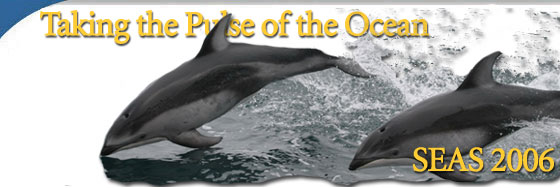|
Life on Board
Meet Crew Member – Art Mercado, Chief Steward and Cook
For over three decades, Art Mercado has worked aboard NOAA ships, and has made friends in every port. Originally from the Philippines, he moved to Hawaii, and since then, he has sailed much of the Pacific, from South America to the Arctic.
From being unable to fry an egg over easy, Mercado worked his way up to his current post as Chief Cook and Steward by taking a six-month cooking course and shadowing a Chief Cook for years. When it comes to standards, he is his own harshest critic: “Everything I cook, I eat.”
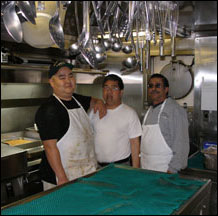 |
| Galley Crew, Mercado, Center |
Mercado caters to the 24/7 dietary needs and culinary preferences of visiting scientists and other on-board guests. Menus reflect an international cuisine, from curries to corned beef, from roast duck to Walking Tall Chicken, a delectable Chinese stir-fry entrée, as well as substantial, delicious vegetarian dishes. New menus are posted daily, offering eggs cooked to order in addition to plentiful fresh fruit and side dishes. Even graveyard shifters are well provided for nocturnal foraging sessions.
Mercado supervises a staff of two, who help maintain his high standards. The kitchen and mess hall are spotless at all times. He must work far in advance to provision for sometimes extended cruises at sea.
During his free time on Sundays, he enjoys fishing and the shipboard barbecue that follows. Home ported in Seattle, Mercado enjoys hunting and fishing in Alaska or visiting friends in Hawaii many of whom he has made along his Pacific journey.
Meet NOAA Corps Junior Officer – Joshua Slater
Navigation and marine science, integrated within the structure of the NOAA Corps, is the perfect blend of work for Joshua Slater, Junior Officer. He is proud to be a member of our country’s seventh uniformed service, and through his skill in the art of navigation, of helping to further ocean research. A graduate from the University of North Carolina Wilmington, he holds a B.S. in Marine Biology and a M.S. in Marine Science. He has served aboard the McArthur II since June 2006.
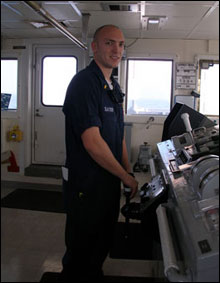 |
| Slater in the Wheelhouse |
Slater’s primary duty is ship’s navigation. He plots track lines reflecting our past and projected course. He negotiates safe passage around other ships – especially important since our surveys outside the Golden Gate take us through some of the most heavily traversed shipping lanes in the country. On-board safety is another of his responsibilities
Although not directly engaged in the science on board, Slater is an important part of it and keeps abreast of research activities, as his work brings him into contact within scientists involved in many disciplines – an opportunity not available in many shore-based positions.
Slater is still discovering the unique qualities of the open sea: “the ocean away from shore is a whole different ocean.” He enjoys encounters with the seas’ creatures – especially the humpbacks and blue whales we’ve sighted on our surveys.
In the course of his career with NOAA, Slater hopes to visit many different parts of the world, from Alaska to South America. Now in the process of relocating to Seattle, Slater will soon give “home port” a deeper meaning: he recently became engaged to a veterinary technician. Congratulations, Slater!
For Internships and Careers at sea, please visit www.noaa.gov, and look under ‘employment’ or www.sanctuaries.noaa.gov under ‘get involved.’
Meet Crew Member Lacey O’Neal, Senior Survey Technician
The McArthur II operates seamlessly in large part because of Lacey O’ Neal. In the dry lab, he uses a bank of computers for collecting oceanographic, navigation and meteorological data. To log physical oceanographic data, he operates the instruments that record sea surface temperature, salinity, chlorophyll concentration, wind direction and speed, ocean depth and bathymetry, and an acoustic profile of the water column that tells scientists where to “fish” for data.
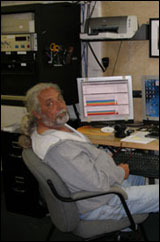 |
| Lacey O'Neal |
After retiring from the Army as a paratrooper, O’Neal joined NOAA. That was nine years ago when he started as Ordinary Seaman, and within a few years, he moved up the ranks to his current level as the vessel’s Senior Survey Technician.
His work takes him to many parts of the world, as the McArthur II runs north as far as the Bering Sea, south to Peru, east to the Panama Canal and west beyond Hawai’i. He enjoys his commute to work: “No traffic – step out my door and I am there.” He is a talented photographer. Next to his computers, hang beautiful photographs of killer whales, common dolphins, humpbacks and lighthouses which he has taken in his free time. A Harley-Davidson rally photo lends insight into his other passion.
We have all come to know O’Neal as the liaison between the ship’s science equipment and the scientists on board. He operates the Scientific Computing System, creates computer display screens that provide scientists with GPS points for their study sites, angle and speed of net deployments, and other information essential to their research. Most importantly we appreciate his great sense of humor, friendliness and helpful knowledge.
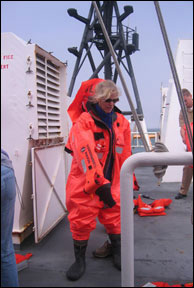 |
| GFNMS Research Coordinator, Jan Roletto in a flotation suit (Photo: Dru Devfin) |
Our research vessel, the McArthur II, is 225 feet of floating steel equipped with some of the latest NOAA technology. Its homeport is Seattle. Twelve scientists join the 19 members on board, a newly formed community. Staterooms are comfortable, and the amenities are surprising, considering the remoteness of the work we will be doing.
Safety First! Our oceanography technician runs us through the first of many safety drills. Seven blasts summon us to prepare to abandon ship. We don our bright orange Gumby-style survival suits and personal flotation devices (PFDs).
We are running 24/7, and our crew is split between two worlds: day and night. First we introduce ourselves to each other; then we are introduced to the instruments we work with, our scientific protocols and our daily routines.
 |
| McArthur II's mess hall (Photo: Jamie Hall) |
The galley crew provides and prepares our meals three times a day. They post menus daily, and they supply basic items for quick sandwiches or snacks incase our work schedules do not allow for dining at routine mealtimes. It is necessary for us to skip some meals, so it is a good thing we stowed away some of our favorite treats from home.
There is a lounge for off duty relaxing set up with a library of movies, books, magazines, and even, a do-it-yourself cappuccino maker. There is an exercise room with treadmills and other equipment to keep us ship shape.
|

